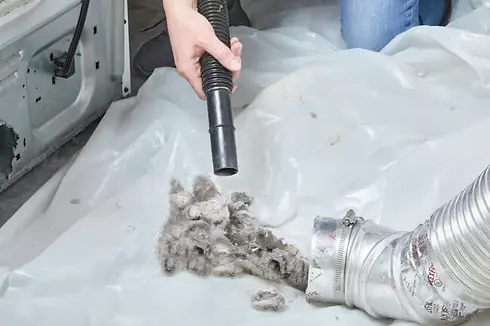
Why Clean Your Dryer Vent?
Regular cleaning of your dryer vent is crucial for maintaining the safety and efficiency of your dryer and reducing the risk of fire hazards. Over time, lint, dust, and debris accumulate in the dryer vent, restricting airflow and causing the dryer to work harder, leading to increased energy consumption and potential breakdowns. Additionally, clogged dryer vents pose a significant fire risk, as lint is highly flammable and can ignite under the heat generated by the dryer. Proper dryer vent cleaning ensures optimal performance, extends the lifespan of your dryer, and most importantly, enhances safety for you and your family.
Importance of Dryer Vent Cleaning:
Prevention of Fire Hazards
According to the U.S. Fire Administration, an estimated 2,900 home clothes dryer fires are reported each year, resulting in injuries, deaths, and millions of dollars in property damage. The leading cause of these fires is failure to clean the dryer vent. Regular vent cleaning removes lint buildup, reducing the risk of dryer fires and ensuring a safer home environment.
Improved Dryer Efficiency
A clogged dryer vent restricts airflow, causing the dryer to run longer and use more energy to dry clothes. By cleaning the vent, you can restore optimal airflow, allowing the dryer to operate more efficiently and reducing energy consumption and utility costs.
Prevention of Carbon Monoxide Buildup
Gas dryers produce carbon monoxide, a colorless and odorless gas that can be deadly if not properly vented. A blocked dryer vent can cause carbon monoxide to accumulate in your home, posing a serious health risk to occupants. Regular vent cleaning ensures proper ventilation and prevents the buildup of carbon monoxide, safeguarding your family's health and well-being.
Extended Dryer Lifespan
Continuous operation of a dryer with a clogged vent can lead to overheating and premature wear and tear on the appliance's components. By cleaning the vent regularly, you can extend the lifespan of your dryer and avoid costly repairs or replacements.
Safety Statistics:
The National Fire Protection Association (NFPA) reports that failure to clean dryer vents is the leading cause of home clothes dryer fires, accounting for 34% of all dryer fires. These fires result in an average of 100 injuries, five deaths, and $35 million in property damage annually. However, regular dryer vent cleaning can significantly reduce the risk of dryer fires and ensure a safer home environment for you and your family.
Additionally, the Consumer Product Safety Commission (CPSC) recommends annual inspection and cleaning of dryer vents to prevent lint buildup and reduce the risk of fire hazards. By investing in professional dryer vent cleaning, you can protect your home, your family, and your property from the dangers associated with clogged dryer vents.

The Dryer Vent Cleaning Process:
Inspection
Our trained technicians begin by inspecting your dryer vent system to assess its condition and identify any blockages or damage that may be present.
Preparation
Before cleaning, we disconnect the dryer from the vent system and move it away from the wall to access the vent duct more effectively. We also take precautions to protect your home and belongings from dust and debris during the cleaning process.
Reconnection and Testing
Once the vent cleaning is complete, we reconnect the dryer to the vent system and conduct a test run to ensure proper airflow and dryer performance. We also check for any signs of leaks or damage and make any necessary repairs or recommendations.
Final Inspection
Our technicians perform a final inspection to verify that the dryer vent is clean and functioning optimally. We provide you with maintenance tips and recommendations to help you keep your dryer vent clean and safe between professional cleanings.
Cleaning
Using specialized tools and equipment, our technicians thoroughly clean the entire length of the dryer vent, removing accumulated lint, dust, and debris. We ensure that all blockages are cleared and that the vent duct is free from obstructions.





_.png)
.png)

